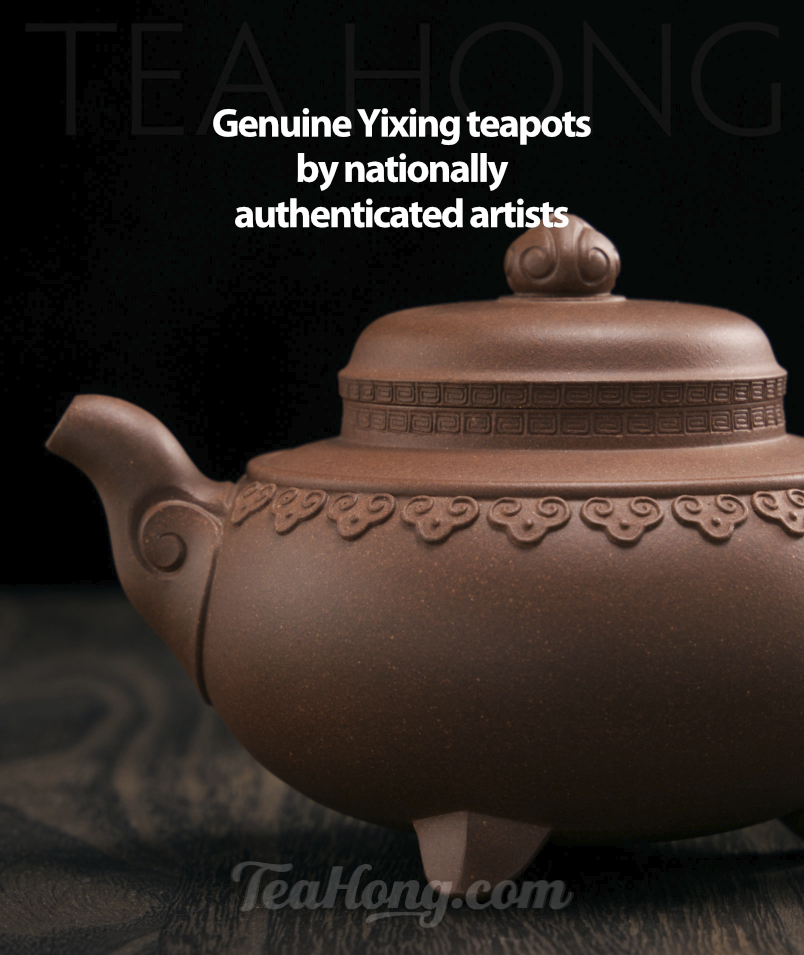Luan Guapian, Big Leaf Green Tea
lù•ãn guā•piàn 六安瓜片
roast-baked green tea
origin: Luan, Anhui
Unlike most other premium green tea, where plucking should take place when the leaf buds are just flushing, and when the tips are still shoots, plucking for Luan Guapian is waited until the young leaves are quite spread.
origin of Luan guapian
This was not exactly an invention when the tea variety came about in early 20th century. Da Cha, or Big (Leaf) Tea, has always been plucked when the leaves are big enough. It has been so for as long as people could remember in the area of what is now known as Luan, in the western part of Anhui province.
The local tea cultivars here were a bit larger in leaf size, and needed to be waited out till a bit more grown before plucking otherwise they would be too bitter. It was not a problem before the 15th century when tealeaves were steamed and compressed and then grounded for consumption so the leaf size did not matter much. The locality had been a much praised tea origin and a source of tribunal tea.
Later when loose leaf tea were in vogue these larger leaves soon lost its mass appeal because of competition from small and even leaves of other varieties in other regions. Da Cha’s market turned local.
Tea farmers here had their change of fate in the very early 1900’s. They began to realize that if the evenness of the size and tenderness of the plucks were maintained before the first contact of heat in the roasting wok, the speed in which individual leaves are cooked could be a lot more even and thus the taste could be so much finer and the final appearance much more appealing. (As a matter of fact, this is the case for almost all fine green tea.) Luan Guapian has since been a famous name amongst tea connoisseurs.
Luan Guapian is a distinctive representation of roast-baked green tea.
roast-baked production
The shade-wilted leaves are wok-roasted very briefly for “sha-qing” and then basket baked. Traditional quality ones are left to cool overnight before subsequent bakings completely dry the tea. This wait wasted some of the floral aroma, but allows time for moisture and residual enzymes in the leaves to dissipate and disperse evenly in the thickness of the leaf. The two to three rounds of baking in the following day can then evenly and quite completely cure and dry the leaves for the balance of taste and aroma. And most importantly, a reasonable shelf-life. Residual enzymes, when not taken care of, can change the taste and aroma upon storage.
There are a few counties under the administrative definition of Luan. Those in the blue mountains (Da-bie Shan) west of the famous Huangshan (Yellow Mountains) are responsible for the production of this tea. So are many tea cultivars. There used to be a local culture here to obtain new tea trees by planting the seeds. Sexual propagation inevitably gives rise to new cultivars. Through centuries of such practice, scholars are now facing an immense challenge in telling the huge varieties of cultivars used in the production of this tea.

Infusion of the green tea Luan Guapian, with an infused leaf
cultivar da guazi
Local officials said that a family of cultivars nicknamed Da Guazi (translates: large size sunflower seeds, after the shape of the young leaves which edge curls backward to look as if they were large sunflower seeds with the shell) are responsible for over half of the production. The remaining half is taken care of by three other families. People presume this mid-size Da Cha tea plant, the Da Guazi, is the original Luan Guapian cultivar. The taste from different cultivars can be different and the marketplace is filled with different tasting selections. Price is not necessarily a reflection of the taste quality.
tasting Luan guapian
This review is based on a selection we have screened from the market as being the finest we can find. It comes from Huoshan, about 60km south of the township of Luan but within the county.
Most Luan Guapian can be quite bitter when infused with very hot water. Some people like it that way. This one from Huoshan has a clean bitterness that gradually turns sweet. It quenches thirst and stays sweet in the back of the palate and top of the throat for a very long time.
When infused at around 85°C, the bitterness is much subdued and integrates smoothly with the rest of the tastes. The aftertaste is sweet, but not as dramatic as when infused hot.
Infused at whether high or lower temperature, the taste is clean, crisp, vibrant and yet not grassy. It is quite round for a green tea. The texture is amazingly velvety, almost comparable to bouquet style Tieguanyins. The aroma is more distinctive with floral and herbaceous accents when prepared at higher temperature. Those who desire all the better character of the tea but do not want it to be bitter can prepare the tea with the ice-fire approach.
We like this tea for its unique clean taste and dramatic variations using different infusion styles. Compared to other ultra famous names in green tea, I think Luan Guapian is much under-rated at the moment, and therefore, it is a good time for tea gourmets to try it out before its price goes up.











